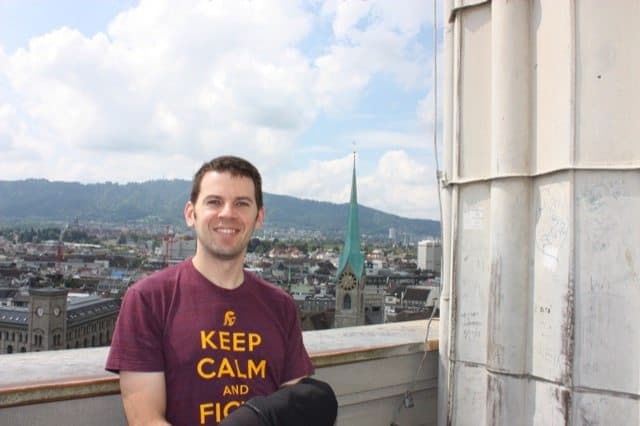If you can't manage to join us for one of our guided tours of the Golden Gate Bridge, we've created this self-guided tour to give you another option.
We also have a GPS-powered Golden Gate Bridge audio tour that you might want to consider instead.
Don't forget that we also have a full post explaining how to get here, where to park, and how to walk across the bridge.
The tour begins just outside the Golden Gate Bridge gift shop, at the large bronze statue of Joseph Strauss.
SELF-GUIDED GOLDEN GATE BRIDGE WALKING TOUR
Stop 1: Joseph Strauss Statue
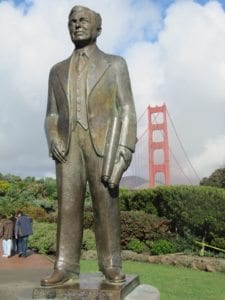
We're going to start our tour at the statue honoring Joseph Strauss.
For every major infrastructure project in America, there is often one person who has to push the project through with sheer force of personality.
For the Golden Gate Bridge, that man was Joseph Strauss.
Joseph Strauss is credited with being the designer and chief engineer of the Golden Gate Bridge (even though Strauss himself wasn't even an engineer!)
Strauss, over everybody else, was the person responsible for the bridge being built.
When most people thought that it would be an impossible task, Strauss was able to convince the government, the public, and the banks that the bridge was possible.
Strauss had an ego as big as the bridge itself. But for a project as massive as this one, a huge ego can often be a useful trait rather than a drawback.
When everybody believed that building this bridge would be an impossible task, somebody had to have the confidence to believe that they could achieve the impossible.
And Joseph Strauss was that man.
Starting at the Strauss statue, turn to the right and walk down a small flight of stairs. Follow the walking path as it curves to the left.
Stop 2: Men of Vision Plaque
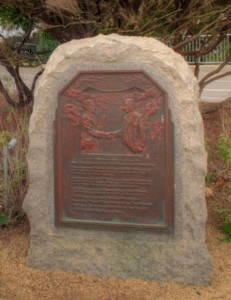
Although Joseph Strauss had a vision for the Golden Gate Bridge, he could not build it alone. The first thing he needed was money.
And building what many thought was an impossible bridge was going to require a lot of money!
Luckily, San Francisco was home to another visionary. His name was Amadeo "A.P." Giannini.
If you have taken our North Beach/Little Italy walking tour you would have heard about Giannini!
Giannini was willing to lend all the money that was required to build the Golden Gate Bridge.
It was a huge undertaking with a massive risk involved, but he believed it was the right decision.
The plaque that you are standing in front of commemorates the meeting of Giannini and Strauss which sealed the future for the bridge.
Continue walking down the path as it curves to the left. You will see a patch of dirt just off the paved road with a great view of the bridge.
Stop 3: A Great Photo Stop!
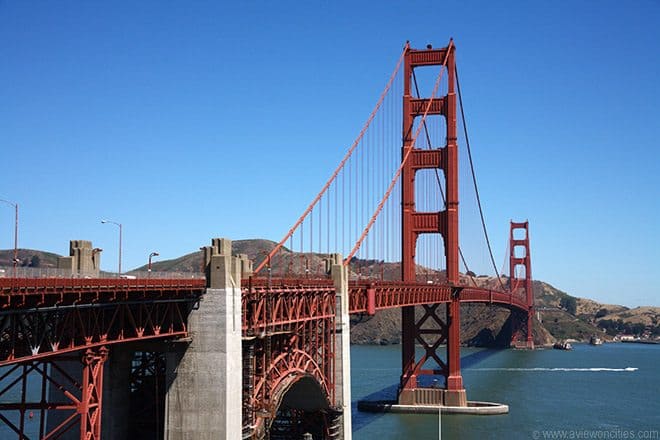
Since we are always on the lookout for the best photography spots, we have to mention this one.
This area is possibly the best place in all of San Francisco to take a picture of the Golden Gate Bridge.
So get out that camera and snap a memorable photo (or selfie!) to store in your photo book.
Take a few steps back to return to the paved walking path. Walk up the hill towards the bridge.
As you continue on the path, you will walk underneath the bridge (and another great stop for a photo)!
Continue to the other side of the bridge, and you will see a large steel beam that is the same color as the bridge. Stop in front of that.
Stop 4: Earthquake Testing and Retrofitting
As many people know, San Francisco has suffered through many major earthquakes in its history.
The largest of these was the 1906 earthquake, which was estimated to be a 7.8 on the Richter scale (we don't actually know precisely because the earthquake was so intense that it damaged the machine that was built to measure earthquakes!)
Since 1906, the city has experienced numerous other strong earthquakes.
Because of the danger that earthquakes pose, we have to know to a high degree of certainty that the Golden Gate Bridge will survive a strong earthquake.
As part of the design process during the creation of the bridge, scientists put models of the bridge under severe stress to figure out which parts of the bridge would cause trouble.
As you can see from this large beam that is bent in the middle, the researchers discovered one possible fault in the bridge.
They fixed it before the bridge was ever built, but they kept this bent beam for visitors to see.
Walk back under the bridge, and walk up the hill towards the right. At the top of the hill, you'll see a set of stairs with a large flagpole at the top. Walk up to the area with the flag.
Stop 5: A View of the Bridge
How Did the Golden Gate Bridge Get Its Name?
Many people think the Golden Gate Bridge was named because of the gold that was discovered in California during the famous Gold Rush. Not true!
If you go all the way back to the year 1846 and you stood in this spot, you would see a wide-open area between San Francisco and Marin County to the north.
In that year, Captain John C. Fremont sailed a ship through that area into San Francisco Bay.
As he was sailing through, he commented that it was so beautiful that he was going to name it "Chrysopylae," which, translated into English, means "Golden Gate."
This area kept that name for over 80 years, and when the bridge was built across it, they kept the Golden Gate name.
What to See from This Spot
If you're looking at the bridge, the first thing you will see behind it is a vast open expanse of land called the Marin Headlands.
This open space was one of the biggest victories that conservation groups have ever achieved in the United States.
Many developers wanted to build houses and businesses on this land, but the local citizens banded together to protect this amazing land.
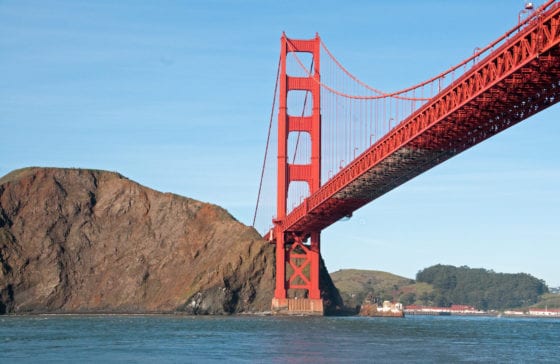
Looking out at the bay, you'll also see two important islands.
The first is Alcatraz Island, the famous prison that has turned into a tourist attraction (for information on visiting Alcatraz, check out our post on how to get to Alcatraz.
To the left of Alcatraz, you'll also see Angel Island. This island has been called the "Ellis Island of the West."
When immigrants from Asia sailed into the United States in large numbers hoping to start a new life, their first stop was always on Angel Island. From there, they were able to begin their lives in America.
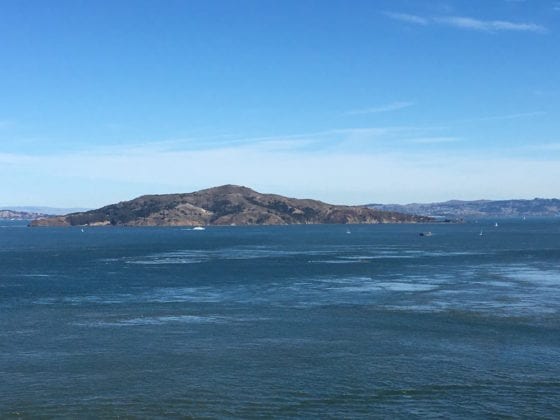
While looking at the bridge, turn left. You will see a concrete wall with bushes in front of it. There is a walking path through the wall.
Walk through that path until you are right next to the road. From here, you can begin your walk over the bridge. You can walk as far as you like, but we'd recommend stopping at the second concrete pillar on the bridge.
Stop 6: The Anchorage
The Construction of the Bridge
From this point, you can look all the way up to the top of the tower, and all the way down to the water. From top to bottom, the bridge is 746 feet (227 meters) tall.
When the bridge was built, it was the longest suspension bridge in the world, with a distance between towers of just under three-quarters of a mile (1.3 km).
And as a testament to the bridge's incredible engineering, it stayed the longest suspension bridge for nearly 30 years.
Looking up the South Tower, you can just begin to imagine what it must have been like for the workers to be over 700 feet above the water, working in some of the windiest conditions anywhere.
(The idea gives us sweaty palms just thinking about it!) But their work created the amazing bridge that we can enjoy today.
The Bridge Cables
The Golden Gate Bridge has two types of cables. The first, and most prominent, are the main cables. These cables are 36.5 inches (93 cm) in diameter and are made of over 27,000 individual steel cables.
These cables are the structures that bear the weight of the entire bridge.

The smaller cables, hanging in sets of four every 50 feet along the roadway, are what transfers the weight of the road to the main cables.
Painting the Bridge
There is a common myth that the bridge gets painted from one end to the other, and by the time the painters finish the bridge, it's time to go back to the beginning and start painting all over again.
Although this is not exactly true, it does have some bit of truth.
The bridge does get painted constantly. There is a team of painters who is on the bridge all year long. But they do not go from one end to the other.
They go wherever they are needed to paint the spots that need the most work. This is a constant process since the bridge gets exposed to salt air that corrodes the bridge on a daily basis.
From here, you can walk as long as you want. But we recommend stopping at the first tower of the bridge. There is a small alcove as you walk around to the right of the tower, and you can pause there and look out at the scenery. It is a bit quieter here without all the automobile noise!
Stop 7: The South Tower
From here, you can see a large amount of downtown San Francisco! Here are some of our favorite sites:
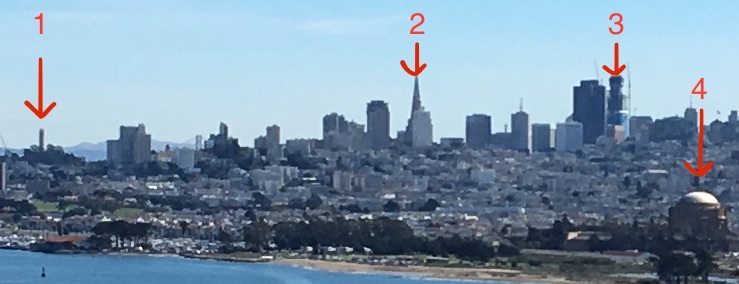
1. Coit Tower
Coit Tower is an art deco-style tower that was created in 1933 in honor of one of our favorite San Francisco ladies: Lillie Hitchcock Coit. You can learn more about Lillie Coit on our North Beach/Little Italy walking tour.
But she was a fascinating lady who lived in San Francisco in the late 1800s. When she died, she left her large fortune to the City of San Francisco for them to create beautiful additions to the city.
San Francisco used a large portion of her fortune to build Coit Tower (with some money left over to create a statue in North Beach that honors the city's volunteer firefighters).
If you want a fantastic view of downtown SF, you can't beat Coit Tower. Read our full post on the tower.
3. Salesforce Tower
This building, currently under construction, will soon take over the title of the tallest building in San Francisco.
In fact, it will be taller than the Transamerica building by over 200 feet (63 meters)! This will also be the second tallest building in the entire western United States.
Salesforce is one of the largest companies in San Francisco, and they are building this incredible tower to be the flagship building of the company.
This building will be connected to the San Francisco Transbay Terminal, a massive new public transportation complex that will connect the subway, buses, and new California high-speed rail.
2. Transamerica Pyramid
The 853-foot (260-meter) Transamerica building is currently the tallest building in San Francisco (though that title is about to change). It was created to be the headquarters of the Transamerica company.
When it was first designed by William Pereira, it was a very unpopular design. But over the years, it has come to be not just accepted but celebrated as the most famous building in this extremely famous skyline.
If you want to learn more about this building and its Italian heritage, you can join our North Beach/Little Italy walking tour!
4. Palace of Fine Arts
This Beaux-Arts masterpiece was created for the 1915 World's Fair, held in San Francisco.
The city hosted the World's Fair to show off how much San Francisco had advanced since the massive destruction of the 1906 earthquake and fire.
One of the largest natural disasters in history, the 1906 earthquake destroyed about 80% of the city. San Francisco wanted to show off to the entire world how much the city had rebuilt and modernized.
The Palace of Fine Arts was designed to only last a short time--for as long as the year-long fair was running.
But the people of the city loved the building so much that the city decided to rebuild it in a more permanent way.
Since it was rebuilt, it has remained standing and has become one of the most popular sights in San Francisco.




